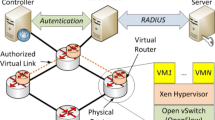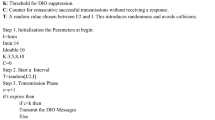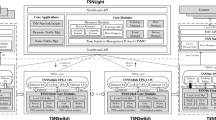Abstract
Several famous priority-based queuing schemes operated in a gateway to support differentiated services among internet traffic. Examining packet forwarding operations in these queueing schemes, they only support a priority-based service either in a packet enqueuing process or in a packet dequeuing process. If a queuing scheme can support priority-based services in both packet enqueuing/dequeuing processes; it would enhance differentiated service performance for internet traffic. This study proposes a priority-based queuing scheme with an adaptive time token allotment measure to support a differentiated packet forwarding process for different types of IP traffic both in packet enqueuing/dequeuing processes. Depending on packet sizes and packet forwarding priorities of IP traffic, the proposed queuing scheme assigns fix and adaptive time token thresholds dynamically to logical queuing buffers separately. With assigned time tokens, logical queuing buffers allow arrival IP packets to be enqueued in a differentiated way. Moreover, the proposed queuing scheme uses a transferred WRR dequeuing measure to enhance a differentiated packet forwarding process. The simulation results show that the proposed queuing scheme supports a differentiated packet forwarding process for different types of IP traffic. The differentiated packet forwarding performance supported by the proposed scheme is close to the IETF DiffServ scheme; this result shows that the proposed scheme can support differentiated packet forwarding performance for different types of IP traffic with a lower operation cost.











Similar content being viewed by others
References
Turner, J. S. (1992, September). Managing bandwidth in ATM networks with bursty traffic. IEEE Network, 50–58.
Park, E.-C., & Choi, C.-H. (2003, December). Adaptive token bucket algorithm for fair bandwidth allocation in DiffServ networks. IEEE Global Telecommunications Conference, 2003. GLOBECOM ’03 vol. 6, pp. 3176–3180, vol. 6, 1–5.
He, D., Zhou, W., & Zhang, X. (2009, November 6–8). A bi-direction adjustable token bucket mechanism for multi-class bandwidth guarantee and sharing. Network Infrastructure and Digital Content, 2009. IC-NIDC 2009. IEEE International Conference on, pp. 65–68.
Ghazal, S., Ben Othman, J., & Claudé, J.-P. (2011). Traffic management based on token bucket mechanism for WiMAX networks. Cluster Computing, 15(4), 391–400.
Liao, J., Wang, J., Li, T., Wang, J., & Zhu, X. (2011). A token-bucket based notification traffic control mechanism for IMS presence service. Computer Communications, 34(10), 1243–1257.
Zhao, W., Olshefski, D., & Schulzrinne, H. (2000, February) Internet quality of service: An overview. Technical report CUCS-003-00, Columbia University.
Tsai, T., Jiang, C., & Wang, C. (2006). CAC and Packet scheduling using token bucket for IEEE 802.16 networks. Journal of Communications, 1(2), 30–37.
Ke, C. H., Shieh, C. K., Hwang, W. S., & Ziviani, A. (2005). A two-markers system for improved MPEG video delivery in a diffserv network. IEEE Communications Letters, 9(4), 381–383.
Ferrari, T., Pau, G., & Raffaelli, C. (2001). Measurement based analysis of delay in priority queuing. In Proceeding of IEEE global telecommunication conference globecom 2001. Texas: S. Antonio.
Blake, S., Black, D., & Carlson, M. (1998). An architecture for differentiated services, RFC 2475.
Davie, B., Charny, A., Bennet, J. C. R., Benson, K., Le Boudec, J. Y., Courtney, W., et al.. (2002). An expedited forwarding PHB, RFC 3246.
Heinanen, J., Baker, F., Weiss, W., & Wroclawski, J. (1999). Assured forwarding PHB, Group, RFC2597.
Assi, Chadi M., Yinghua, Ye, Sudhir, Dixit, & Ali, Mohamed A. (2003). Dynamic Bandwidth Allocation for Quality-of-Service over Ethernet PONs. IEEE Journal on Selected Areas in Communications, 21(9), 1467–1477.
Mohamed, A., & Tho, L.-N. (2008). Priority queuing of long-range dependent traffic. Computer Communications, 31(17), 3954–3963.
Lin, A.-M., & Silvester, J. A. (1991). Priority queueing strategies and buffer allocation protocols for traffic control at an ATM integrated broadband switching system. IEEE Journal on Selected Areas in Communications, 9, 1524–1536.
Andrikopoulos, I., et al. (1999). Providing rate guarantees for internet application traffic across ATM networks. IEEE Communications Surveys, 2(3), 2–13.
Roth, R., Campanella, S., Leinen, R., Sabatino, N., Simar, M., Przybylski, M., et al. (2003). IP QoS across multiple management domains: Practical experiences from pan-European experiments. IEEE Communications Magazine, 41(1), 62–69.
Hofmann, U., Miloucheva, I., Strohmeier, F., & Pfeiffenberger, T. (2002, October 3–6). Evaluation of architectures for QoS analysis of applications in Internet environment. In The 10th international conference on telecommunication systems, modeling and analysis Monterey, CA, USA.
Kim, C., et al. (2006). End-to-end QoS monitoring tool development and performance analysis for NGN. In: Kim, Y.-T., Takano, M. (Eds.) APNOMS 2006. LNCS, 4238. pp. 27–29.
Lee, T.-H., & Huang, Y.-W. (2008). Effective transmission opportunity allocation scheme for real-time variable bit rate traffic flows with different delay bounds. Communications, IET, 2(4), 598–608.
Adibi, S., & Agnew, G. B. (2008). Multilayer flavoured dynamic source routing in mobile ad-hoc networks. Communications, IET, 2(5), 690–707.
Ubik, S., Smotlacha, V., Saaristo, S., & Laine, J. (2001, June). Low-cost precise QoS measurement tool. CESNET Technical report.
Floyd, S., & Jacobson, V. (1995). Link sharing and resource management models for packet networks. IEEE/ACM Transactions on Networking, 3(4), 365–386.
Habib, A., Fahmy, S., & Bhargava, B. (2005). Monitoring and controlling QoS network domains. International Journal of Network Management, 15, 11–29. doi:10.1002/nem.541.
Konstantina, P., Sue, M., Chuck, F., Patrick, T., & Christophe, D. (2003). Measurement and analysis of single-hop delay on an IP backbone network. IEEE Journal on Selected Areas in Communications, 21(6), 908–921.
Baek-Young, C., Sue, M., Zhi-Li, Z., Konstantina, P., & Christophe, D. (2007). Analysis of point-to-point packet delay in an operational network. Computer Networks, 51(13), 3812–3827.
Fu, C.-H. (2010). A study on differentiated service queuing scheme with an overflow buffer allocation 591 within a UMTS core network. Wireless Personal Communications, 55(3), 325–347.
Author information
Authors and Affiliations
Corresponding author
Rights and permissions
About this article
Cite this article
Fu, C.H. A Study on Adaptive Time Token Priority-Based Queuing Scheme. Wireless Pers Commun 72, 1051–1075 (2013). https://doi.org/10.1007/s11277-013-1055-6
Published:
Issue Date:
DOI: https://doi.org/10.1007/s11277-013-1055-6




